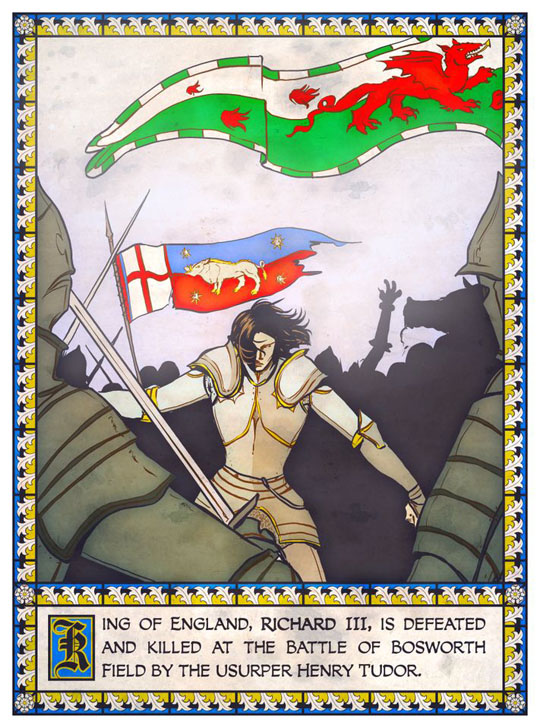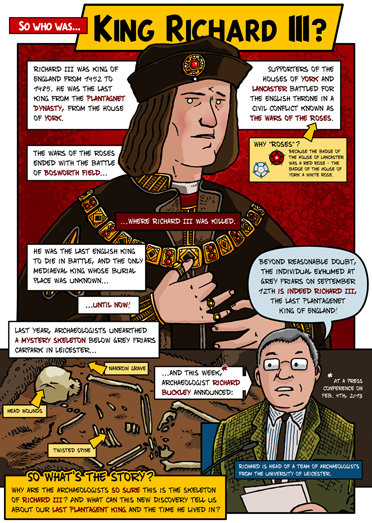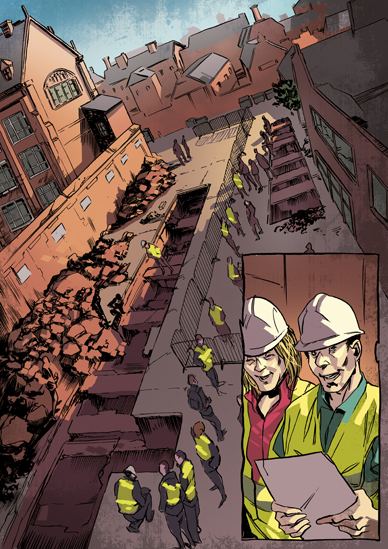Richard III Craze Inspires Comic Art

The discovery of the long-lost bones of Richard III has sparked new interest in the controversial king — and with it, comics to illustrate his legacy.
"Richard has been an obsession of mine for a long time," comic artist Emma Vieceli said in a statement. "I remember when I was in senior school we studied the Tudors, but there was only a brief mention of Richard — simply to say he was a villain! I can remember even as a kid thinking 'that seems a bit dismissive.'"
Vieceli, who is working on a graphic novel about Richard's life, was commissioned to put together a series of panels telling the king's story for England's University of Leicester.
Last summer, archaeologists from the university found the lost medieval church Grey Friars buried underneath a parking lot in Leicester. And in February, researchers announced that a mutilated skeleton found in the church was confirmed to belong to King Richard III through DNA testing and other measures. [Gallery: In Search of the Grave of Richard III]
Richard became England's monarch in 1483 after his brother King Edward IV died. Declared bastards, Edward's two young sons weren't seen in public after Richard became king, leading to speculation that he had the princes murdered.

After Richard III died in 1485, in battle during the War of the Roses, an English civil war, the Tudors took power and smeared his name. William Shakespeare used these evil portrayals of the king as inspiration for the hunchbacked, sinister protagonist of his play "Richard III," cementing the monarch's bad reputation.
Richard III may have been vilified after his death, but he has coalitions of defenders today, known as Richardians. The grave discovery reinvigorated the debate about the king's true character and his final resting place. All that fanfare also inspired archaeological illustrator John Swogger to make a comic titled "So Who Was Richard III?"
Sign up for the Live Science daily newsletter now
Get the world’s most fascinating discoveries delivered straight to your inbox.
"One of the reasons why I did it was because it just struck me that Britain's past very rarely comes up in terms of national debate," Swogger said in a statement."Almost immediately, there were people squabbling over the burial place — and that just doesn't happen in Britain very often. That really grabbed me."
"Archaeology can be very dull at times, as it is usually about very small things. It is very rare for an English king to pop out of a burial," Swogger added.

Another set of comic art was commissioned by the Leicestershire County Council for an exhibition titled "Richard III: The making of a myth," which is now on display at the Bosworth Battlefield Heritage Centre. Panels by graphic novel artist John Aggs illuminate the king's complicated life and legacy and bring the story to recent archaeological search for Richard's remains.
Richard Knox, the Leicestershire County Council's heritage development manager, said in a statement that Aggs' work "shows the few highs and many lows in Richard's life and short reign."
"It also discusses some of the contradicting legends about him, such as the fate of the Princes in the Tower and the conflicting traditions of his final resting place, which the graphic-novel style can deal with more easily than conventional illustration," Knox added.
Follow Megan Gannon on Twitter and Google+. Follow us @livescience, Facebook & Google+. Original article on LiveScience.com.

Why is yawning contagious?
Scientific consensus shows race is a human invention, not biological reality










